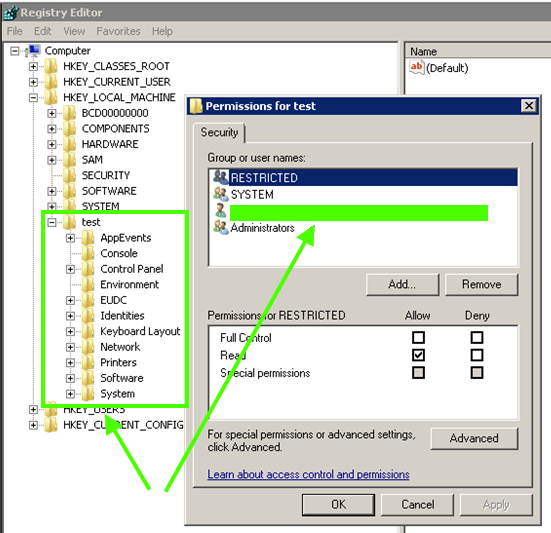Archive
Group Policy Client Error When Logging In
Warning: This post deals with editing the registry. If you don’t know what that is stop right here & ask someone else to help you. Using the registry editor incorrectly can cause serious problems that may require you to reinstall Windows. Use the registry editor at your own risk.
Everytime a user tried to log into any of the Terminal Servers she got an error that said, “The Group Policy Client service failed the logon. Access is denied.”

No one else was having the issue on any of the Terminal Servers.
Long story short, her roaming profile was bad. What you can do to verify is open Regedit & mount (e.g. Load Hive) the user’s ntuser.dat file to a temporary key name. Look at the permissions of that node.

Yeah, that’s all messed up. It should look more like this.

So in my case I renamed her roaming profile on the file server from username to username.bak & had her try to log in again. It created a new profile & all was good. Had to reconfigure a few things once she was logged in but redirected folders took care of most of the things that would have gone missing.
Error Loading Roaming Profile
Warning: This post deals with editing the registry. If you don’t know what that is stop right here & ask someone else to help you. Using the registry editor incorrectly can cause serious problems that may require you to reinstall Windows. Use the registry editor at your own risk.
Description – When a user with a roaming profile logs on to a Windows Server 2008 Terminal Server they receive an error that says, “Your user profile was not loaded correctly! You have been logged on with a temporary profile. Changes you make to this profile will be lost when you log off. Please see the event log for details or contact your administrator.”

Once the user logs in they are able to function somewhat normally. But if you look in C:\Users you see a folder called TEMP instead of one for their username. And of course like the error said, any changes will not be saved when they log off.
Cause – There are several reasons this can happen but it is most likely caused by a corrupt Profile.
Solution – With the user logged off verify that the TEMP folder in C:\Users is gone. Open the registry & browse to HKLM\SOFTWARE\Microsoft\Windows NT\CurrentVersion\ProfileList. Look through each sub-key until you locate the key for the user in question (look at the ProfileImagePath value). Delete the key (it will start with S-1-5). Close Regedit. No reboot needed. Have the user log in & it should pull their roaming profile correctly.
Can’t See all Terminal Servers in Terminal Services Manager
One of the ways I use to manage all Terminal Services session across all Terminal Servers is via Terminal Service Manager. When you open it, it will show all Terminal Server on the network. I recently ran into a little quirk. After moving all the FSMO roles from my old Server 2003 DC to my new 2008 R2 DC, I only saw the Terminal Servers on the local subnet & not the ones in a different data center.
For a detailed explanation see the link below. The short answer is that if the Computer Browser service isn’t running on the PDC emulator, then you will only see the servers/computers on the local subnet & therefor only see the Terminal Servers on the local subnet in Terminal Services Manager.
Exchange 2010 Transition Gotcha
I’ve been working on a transition from Exchange 2003 to 2010 for the past few months. I did a lot of testing in a lab and caught several things in the lab that saved tons of time in the production rollout. Unfortunately, during the production rollout I ran into an issue that I was not prepared for. I still have Terminal Servers using Outlook 2003. I noticed the following behavior:
- Outgoing emails stay in the Outbox for about 1 minute.
- New email arrival takes about 1 minute.
- Items that are deleted don’t disappear for about 1 minute.
- If you try to delete the “deleted” email again you get an error that says, “Unknown error” then the “deleted” email goes away.
- Items that are moved to another folder take about 1 minute to move.
There is a known issue using Outlook 2003 in online mode (http://support.microsoft.com/kb/2009942). The KB article has a very good technical explanation. There are 2 workarounds mentioned in the KB article but there are really 3. Method 2 is not an option because I cannot run Outlook in cached mode on a Terminal Server. I implemented the registry fix in method 1 setting it to the lowest value. While it does speed it up from 60 seconds to 5, it is still going to cause a negative user experience. The third options is of course upgrading to Outlook 2007 or higher.
So for right now my transition is in a holding pattern until I can update all my Terminal Servers to the latest version of Office. Good thing I only moved over a few users that are OK with dealing with the problem until then. Keep this in mind if you are moving to Exchange 2010.
Port 3389 Not Listening
After upgrading one of our Windows Server 2003 Terminal Servers to SP2 (I know it’s been out forever.) we could not connect to an RDP session. The Terminal Services service was running but if I did a netstat -nao there was nothing listening on port 3389. 5 reboots didn’t seem to fix it. I tried all kinds of registry & file comparisons with a working Terminal Server, running Process Monitor during boot but nothing seemed to point me in the right direction. After about 3 hours I decided I would try re-installing SP2. After the reboot everything seemed to be working properly again. Weird.
Error Installing Software on a Terminal Server
Description – When installing software on a Terminal Server you receive an error that says, “Only administrators have permission to add, remove, or configure server software during a Terminal services remote session. If you want to install or configure software on the server, contact your network administrator.” You receive this error even if you are a local administrator.
Solution 1 – Log in to the console or RDP to the Console/Admin session. Use “mstsc /console” on Windows Server 2003 or “mstsc /admin” on Windows Server 2008.
Solution 2 – Browse to HKLM\Software\Policies\Microsoft\Windows\Installer. Create a DWORD value called EnableAdminTSRemote & set it to 1
Error Uninstalling Office 2000 on a Terminal Server
Description – When removing Office 2000 from a Terminal Server running in application mode you receive an error that says, “Some default settings in Microsoft Office 2000 setup do not work properly on a Windows Terminal Server. To install Office on Terminal Server, you must use the instructions and tools available in your Office 2000 Resource Kit or at http://www.microsoft.com/Office/ORK.” You may also receive this error when users try to run one of the Office applications.
Cause – Office was installed prior to the Terminal Server being switched to run in application mode and the Terminal Server transform was not used.
Solution – Manually remove Office 2000 then reinstall.
- Download & install the Office 2000 Resource Kit.
http://download.microsoft.com/download/6/b/3/6b34f4c7-44e6-4d85-91d9-1acf9479da7d/orktools.exe
- Browse to C:\Program Files\ORKTools\ToolBox\Tools\Office Removal Wizard & run OFFCLN9.EXE.
- Delete any remaining Office folders such as C:\Program Files\Microsoft Office\Office.
- Download & install the Windows Installer Cleanup Utility.
http://download.microsoft.com/download/e/9/d/e9d80355-7ab4-45b8-80e8-983a48d5e1bd/msicuu2.exe
- Run the Windows Installer Cleanup Utility & remove the Office 2000 entry.
- Copy the TermSrvr.mst file from C:\Program Files\ORKTools\ToolBox\Tools\Terminal Server Tools to the location of the Office 2000 setup files.
- Click Start>Settings>Control Panel>Add/Remove Programs>Add New Programs.
- Browse to the location of the Office 2000 setup files & run setup.exe using the transform file.
- \\<servername>\<share>\SETUP.EXE TRANSFORMS=\\<servername>\<share>\TermSrvr.mst



